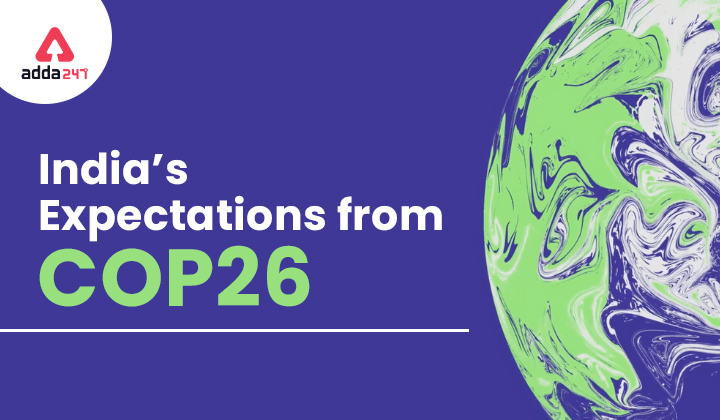GS Paper 3 : Environmental Pollution & Degradation; International Treaties & Agreements; Government Policies & Interventions
Introduction:
The goal of COP 26 is to prevent the average global temperature from rising more than 1.5 degrees Celsius compared with levels before the Industrial Revolution. That’s the threshold beyond which scientists say the dangers of global warmings — such as deadly heatwaves, water shortages, crop failures and ecosystem collapse — grow immensely.
For achieving this, the big push at COP-26 will be to have more countries commit to a “net-zero” deadline by mid-century. This would mean ensuring that a country’s emissions are balanced out by absorbing an equivalent amount either by carbon sinks (such as forests) or carbon capture and storage technologies.
India’s Stand:
- India, the world’s third-largest emitter, has not agreed to a net-zero deadline.
- India is among the countries – China, Australia, Russia – that have yet to make new pledges to cut their pollution.
- However, India may make additional commitments or announcements, taking into account its overachievement of 2030 pledges and ambitious renewable energy goals of 450 GW, and aligning it with the 2047 timeline, coinciding with 100 years of independence.
Why has India not agreed to a net-zero target?
- India sees a mid-century target upon itself as opposed to the principle of “common but differentiated” responsibility that allows countries to eschew fossil fuel without compromising equitable development.
- Net-zero means that a country must commit to a year beyond which its emissions won’t peak and a point at which it will balance out its emissions by taking out an equivalent amount of greenhouse gas from the air.
- Even theoretically committing to a net-zero by 2050 would require India to retire its coal plants and fossil fuel use overnight and even this will not guarantee that temperature-rise stays below 5 degrees Celsius by the end of the century.
- India avers most of the countries clamouring for a net-zero target for India will continue to pollute on a per capita basis way beyond their fair share.
- India says countries responsible for the climate crisis have not made good on previous promises to fund mitigation and adaptation projects and so future net-zero promises are therefore hollow.
What are India’s expectations from COP26?
- Huge expectations in COP 26 include arriving at a consensus on unresolved issues of the Paris Agreement Rule Book, long-term climate finance, market-based mechanisms.
- The COP26 should also be initiating the process of setting the long-term climate finance for the post-2025 period.
- India welcomed the COP 26 Presidency’s five key initiatives on sustainable land use, energy transition, low emission vehicle transition, climate finance and adaptation.
- India was also hoping to strengthen global climate initiatives including the International Solar Alliance, Coalition Disaster Resilient Infrastructure (CDRI), leadership Group for Industry Transition (Lead IT Group), Call for Action on Adaptation and Resilience and Mission Innovation.
What are India’s core demands?
- India has said it is “open to all options” provided it gets assurances that commitments in previous COPs such as developing countries getting compensated to the tune of $100 billion annually, the carbon-credit markets be reinvigorated and the countries historically affected by the climate crisis be compensated by way of “Loss and Damages,” and clean development technologies be made available in ways that its industries can painlessly adapt to.
What should be India’s approach to COP26?
- India should introduce equity in the net-zero targets or at least present it as a proposal for discussion.
- India needs to go beyond the $100-billion demand and focus on tangible deliverables.
- India should focus on the development of technology, how to reduce the cost of technology for mitigation and co-development of technology.
- There has to be a mechanism by which CO2 is extracted.
- The world needs to set the price of carbon and it should not be a bilateral discussion point. The private market would put in money only if backed by public money.
- Only $800 billion in finance flows from the trillions of dollars that are talked about is highly inadequate.
- If India is pushed to shut down a coal capacity there is a cost to it. Financial and social costs to it which cannot be solved not just with finance but the price of carbon has to be linked with it.
Conclusion:
For “keeping the hope alive” of constraining global temperature rise to under 1.5 degrees Celsius all countries must commit to cutting emissions faster and deeper than they already are doing. There is also an expectation that wealthy countries will significantly boost financial support to help the most vulnerable nations adapt to the impacts of warming and build economies that don’t depend on fossil fuels.



 TSPSC Group 1 Question Paper 2024, Downl...
TSPSC Group 1 Question Paper 2024, Downl...
 TSPSC Group 1 Answer key 2024 Out, Downl...
TSPSC Group 1 Answer key 2024 Out, Downl...
 UPSC Prelims 2024 Question Paper, Downlo...
UPSC Prelims 2024 Question Paper, Downlo...





